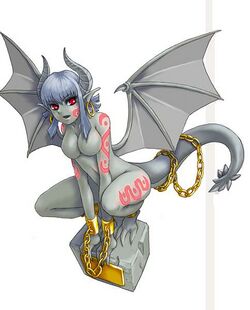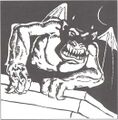Gargoyle: Difference between revisions
1d4chan>Cavgunner |
m (51 revisions imported) |
||
| (29 intermediate revisions by 9 users not shown) | |||
| Line 1: | Line 1: | ||
[[File:Xenomorph gargoyle.jpg|right|300px]] | |||
''If you were looking for the Warhammer 40k creature, see [[Gargoyle (Tyranids)]]'' | |||
'''Gargoyles''' and their cousins grotesques were statues of ugly humanoid monsters, sculpted demons that were popular decorations for churches and, to a lesser extent, the homes of the rich and powerful. The idea was that with their sheer ugliness, they would frighten away actual evil spirits, so they were very popular. Gargoyles are considered an epitome of the Gothic style, and tend to show up all over the place in settings with a Gothic aspiration, especially in "gothick-punk" settings like the old [[World of Darkness]] or Gothic Fantasy settings like [[Ravenloft]]. | '''Gargoyles''' and their cousins grotesques were statues of ugly humanoid monsters, sculpted demons that were popular decorations for churches and, to a lesser extent, the homes of the rich and powerful. The idea was that with their sheer ugliness, they would frighten away actual evil spirits, so they were very popular. Gargoyles are considered an epitome of the Gothic style, and tend to show up all over the place in settings with a Gothic aspiration, especially in "gothick-punk" settings like the old [[World of Darkness]] or Gothic Fantasy settings like [[Ravenloft]]. | ||
Technically speaking, a gargoyle is a specific kind of grotesque, having been sculpted around and incorporating a waterspout (their very name, in fact, has the same root word as "gargle"). Few people remember this who aren't history buffs. | Technically speaking, a gargoyle is a specific kind of grotesque, having been sculpted around and incorporating a waterspout (their very name, in fact, has the same root word as "gargle"). Few people remember this who aren't history buffs. | ||
=Fantasy Gaming= | |||
Gargoyles are a | Gargoyles are a staple in fantasy games, where they are usually depicted more as grotesques. They are often creatures of living stone, similar to [[golem]]s in many ways, but intelligent, often mimicking living creatures in traits like needing to feed and reproduce, and usually evil - ironically, given the actual gargoyles were supposed to be protectors. [[Clark Ashton Smith]]'s [[Averoigne]] story may have a hand in that . . . | ||
They're typically good at pretending to be statues until they're ready to ambush unsuspecting prey. In [[D&D]] for lower-level parties, if the PCs haven't found a magic weapon yet ... yeah, they're immune to non-magic. The gargs in [[B4: The Lost City]] ''will'' fuck you up unless your DM has planned some way to direct you to where the magic sword is at. | |||
As for other old-school adventures, gargoyles were one of those encounter-table wanderers in [[Drow Trilogy|D1]] (like the [[ghouls]]) whose lair isn't detailed in the setpieces but (unlike the ghouls) we're not told which hex they're from. Just where they're not from. | |||
A stronger version called a marlgoyle appeared in [[S4: The Lost Caverns of Tsojcanth]] and then in 1e's Monster Manual II (where it is misspelled "margoyle"). (The marlgoyle - correctly spelled - roams [[GDQ1-7: Queen of the Spiders]]' encounter tables, if you're using those, which you shouldn't.) Their name may or may not be a pun based off [[wikipedia:Marl|a type of sedimentary rock]]. | |||
2e ([[Lorraine Williams|You Know Who]]) devoted a module to these guys. [[Skip Williams]], [[WG9: Gargoyles]]. It wasn't good. | |||
In | In [[Pathfinder]], they are a breed of lesser Earth [[Element]]al, originally hailing from the elemental planes before migrating to the easier, more prey-rich environment of the Material Plane. | ||
In 5th edition D&D, the fact that gargoyles are earth elementals who can ''fly'' is explained as their being the spawn of [[Ogremoch]], the Evil [[Archomental]] of Earth, who created them in mockery of the Air creatures he so hates. | |||
[[ | |||
In Warhammer Fantasy, Gargoyles are magically animated stone figures. Most, but not all, have Daemonic features such as bat-like wings and bestial features. They may be found guarding ancient ruins, seeming to be part of their decoration. They may also be created by means of certain forbidden rituals. Some may be commanded by their creators, while other follow simple instructions that were given to them long ago – usually to destroy all who trespass on their territory. Mention is also made in the backstory of Aranessa Saltspite of how the previous captain of the pirate ship "The Swordfysh" she joined was eventually eaten by a Sea Gargoyle. | |||
<gallery> | |||
Gargoyle ODD3.png|Original D&D | |||
Gargoyle 1e.jpg|1e | |||
Gargoyle MCV2.jpg|2e | |||
Gargoyle MM 2e.png | |||
Gargoyle 3e.jpg|3e | |||
Gargoyle 4e.jpg|4e | |||
Gargoyle 5e.png|5e | |||
Gargoyle B1.png|Pathfinder | |||
Gargoyle ARG.png | |||
</gallery> | |||
'''Marlgoyle''' | |||
<gallery> | |||
Marlgoyle S4.png|S4 | |||
Margoyle 1e.png|1e | |||
Marlgoyle Polyhedron 22.jpg|Now with wings | |||
</gallery> | |||
==Accordlands== | |||
The ''[[Warlords of the Accordlands]]'' setting, first a card game and then a d20 adaptation, had gargoyles as constructs by the [[Dwarves]]. | |||
Dorfs are K-selected (they live long, breed less) in that setting as in most settings, and are harried by eeevil from the [[Underdark]] also as in most settings. Oh right, and they're not exactly welcoming of non-dwarf immigrants. As to how these dorfs are still alive, the Accordlands floats a solution: same way as the Japanese are still alive, they build robots. | |||
Accordlands gargoyles run the gamut according to how much it costs to build them, and to what the specific need is. Some are sentient; all are dwarf-loyal. With one important exception. | |||
If a sentient gargoyle falls in battle, the dwarves might cut some corners and raise its rubble ''back'' up as a quick-'n-dirty gargoyle. ''These'' tend evil, because they're - face it - undead. They might still be dwarf-loyal(ish), but they're not reliable, and they're abominations. | |||
== | =Disney's Gargoyles= | ||
So, in the early-to-mid 90s, Disney's TV animation division was white hot. So were superhero-action cartoons. Disney hired a comic book writer, Greg Weisman (the guy who would later later make the animated ''Young Justice'' for DC/WB), to develop a new superhero action series for them. ''Gargoyles'' was the result, a 2 season, 65 episode cartoon that was met with wide approval. There was a third season, a 13 episode sequel series the next year, ''Gargoyles, The Goliath Chronicles'', that wasn't met with such approval. | |||
Regardless, Disney's version is worth mentioning here, because they're still well loved. The rules of these Gargoyles are fairly simple: | |||
# They look like winged monsters, with a wide variety of colors (blue, red, yellow, brown, etc.) when not stone. | |||
# They tend to be stronger and tougher than humans. | |||
# Their claws are tough enough, and they themselves are strong enough, to allow them to climb buildings, leaving claw marks embedded in the concrete along the way. | |||
# They turn to stone during the day, and have limited healing during this stone sleep. | |||
# Most of them can glide (not fly, but glide) on those wings. | |||
# They lay eggs, and practice communal child-rearing as a partial result. | |||
# They have a tendency to attach themselves to a location, appointing themselves guardians of the region. | |||
# They also have a tendency to leave themselves unnamed, although allowing others to give them names, particularly of their leaders. | |||
As the series begins, an all male pack of Gargoyles from just-barely-post William the Conqueror Scotland finds themselves in modern Manhattan, thinking themselves the last Gargoyles on Earth. Things develop from there, but that's not the subject of this article, the rules something based on (or ripping off) the show are. | |||
=Monstergirls= | |||
[[File:MGE Gargoyle.jpg|thumb|right|250px|Even the statue of a [[succubus]] can be a horny devil.]] | |||
{{Monstergirls}} | |||
Ironically, although gargoyle [[monstergirls]] rarely get much attention, they actually make a lot of sense. After all, a gargoyle is either a predatory earth elemental that pretends to be a statue, or just an [[Animated Object]] made from a statue, and statues of attractive (often naked) girls have always been popular decorations for people wealthy enough to afford statuary. It makes sense that gargoyles would evolve to resemble (or be created in the image of) statues of beautiful women, because that's a ''lot'' better way to camouflage themselves - after all, realistically, how many people would actually have sculptures of demons or hideous monstrous humanoids around the place? Everybody gets tense when you mention the presence of [[fiend]]ish-looking statues; nobody bats an eye at all the naked women statues. Until they grab you and eat you, anyway. | |||
In the [[Monster Girl Encyclopedia]], gargoyles are believed to be [[demon]]s who were sealed in stone statues before the current [[Succubus]] Lord took over. Inspired by the gargoyles of the 90s Disney cartoon "Gargoyles", they become living flesh and blood during the night, but transform into inanimate stone during the day. So, they try to get people to break the magical shackles binding them so they can use the night as a chance to go husband-hunting. And if you're still locked in coitus when the sun-rises, ''you'' turn to stone too until sundown. | |||
[[Category: Dungeons & Dragons]] [[Category: Monsters]] [[Category: Pathfinder]] | [[Category: Dungeons & Dragons]] | ||
[[Category: Monsters]] | |||
[[Category: Pathfinder]] | |||
Latest revision as of 09:05, 21 June 2023

If you were looking for the Warhammer 40k creature, see Gargoyle (Tyranids)
Gargoyles and their cousins grotesques were statues of ugly humanoid monsters, sculpted demons that were popular decorations for churches and, to a lesser extent, the homes of the rich and powerful. The idea was that with their sheer ugliness, they would frighten away actual evil spirits, so they were very popular. Gargoyles are considered an epitome of the Gothic style, and tend to show up all over the place in settings with a Gothic aspiration, especially in "gothick-punk" settings like the old World of Darkness or Gothic Fantasy settings like Ravenloft.
Technically speaking, a gargoyle is a specific kind of grotesque, having been sculpted around and incorporating a waterspout (their very name, in fact, has the same root word as "gargle"). Few people remember this who aren't history buffs.
Fantasy Gaming[edit]
Gargoyles are a staple in fantasy games, where they are usually depicted more as grotesques. They are often creatures of living stone, similar to golems in many ways, but intelligent, often mimicking living creatures in traits like needing to feed and reproduce, and usually evil - ironically, given the actual gargoyles were supposed to be protectors. Clark Ashton Smith's Averoigne story may have a hand in that . . .
They're typically good at pretending to be statues until they're ready to ambush unsuspecting prey. In D&D for lower-level parties, if the PCs haven't found a magic weapon yet ... yeah, they're immune to non-magic. The gargs in B4: The Lost City will fuck you up unless your DM has planned some way to direct you to where the magic sword is at.
As for other old-school adventures, gargoyles were one of those encounter-table wanderers in D1 (like the ghouls) whose lair isn't detailed in the setpieces but (unlike the ghouls) we're not told which hex they're from. Just where they're not from.
A stronger version called a marlgoyle appeared in S4: The Lost Caverns of Tsojcanth and then in 1e's Monster Manual II (where it is misspelled "margoyle"). (The marlgoyle - correctly spelled - roams GDQ1-7: Queen of the Spiders' encounter tables, if you're using those, which you shouldn't.) Their name may or may not be a pun based off a type of sedimentary rock.
2e (You Know Who) devoted a module to these guys. Skip Williams, WG9: Gargoyles. It wasn't good.
In Pathfinder, they are a breed of lesser Earth Elemental, originally hailing from the elemental planes before migrating to the easier, more prey-rich environment of the Material Plane.
In 5th edition D&D, the fact that gargoyles are earth elementals who can fly is explained as their being the spawn of Ogremoch, the Evil Archomental of Earth, who created them in mockery of the Air creatures he so hates.
In Warhammer Fantasy, Gargoyles are magically animated stone figures. Most, but not all, have Daemonic features such as bat-like wings and bestial features. They may be found guarding ancient ruins, seeming to be part of their decoration. They may also be created by means of certain forbidden rituals. Some may be commanded by their creators, while other follow simple instructions that were given to them long ago – usually to destroy all who trespass on their territory. Mention is also made in the backstory of Aranessa Saltspite of how the previous captain of the pirate ship "The Swordfysh" she joined was eventually eaten by a Sea Gargoyle.
-
Original D&D
-
1e
-
2e
-
-
3e
-
4e
-
5e
-
Pathfinder
-
Marlgoyle
-
S4
-
1e
-
Now with wings
Accordlands[edit]
The Warlords of the Accordlands setting, first a card game and then a d20 adaptation, had gargoyles as constructs by the Dwarves.
Dorfs are K-selected (they live long, breed less) in that setting as in most settings, and are harried by eeevil from the Underdark also as in most settings. Oh right, and they're not exactly welcoming of non-dwarf immigrants. As to how these dorfs are still alive, the Accordlands floats a solution: same way as the Japanese are still alive, they build robots.
Accordlands gargoyles run the gamut according to how much it costs to build them, and to what the specific need is. Some are sentient; all are dwarf-loyal. With one important exception.
If a sentient gargoyle falls in battle, the dwarves might cut some corners and raise its rubble back up as a quick-'n-dirty gargoyle. These tend evil, because they're - face it - undead. They might still be dwarf-loyal(ish), but they're not reliable, and they're abominations.
Disney's Gargoyles[edit]
So, in the early-to-mid 90s, Disney's TV animation division was white hot. So were superhero-action cartoons. Disney hired a comic book writer, Greg Weisman (the guy who would later later make the animated Young Justice for DC/WB), to develop a new superhero action series for them. Gargoyles was the result, a 2 season, 65 episode cartoon that was met with wide approval. There was a third season, a 13 episode sequel series the next year, Gargoyles, The Goliath Chronicles, that wasn't met with such approval.
Regardless, Disney's version is worth mentioning here, because they're still well loved. The rules of these Gargoyles are fairly simple:
- They look like winged monsters, with a wide variety of colors (blue, red, yellow, brown, etc.) when not stone.
- They tend to be stronger and tougher than humans.
- Their claws are tough enough, and they themselves are strong enough, to allow them to climb buildings, leaving claw marks embedded in the concrete along the way.
- They turn to stone during the day, and have limited healing during this stone sleep.
- Most of them can glide (not fly, but glide) on those wings.
- They lay eggs, and practice communal child-rearing as a partial result.
- They have a tendency to attach themselves to a location, appointing themselves guardians of the region.
- They also have a tendency to leave themselves unnamed, although allowing others to give them names, particularly of their leaders.
As the series begins, an all male pack of Gargoyles from just-barely-post William the Conqueror Scotland finds themselves in modern Manhattan, thinking themselves the last Gargoyles on Earth. Things develop from there, but that's not the subject of this article, the rules something based on (or ripping off) the show are.
Monstergirls[edit]

 | This article or section is about Monstergirls (or a monster that is frequently depicted as a Monstergirl), something that /tg/ widely considers to be the purest form of awesome. Expect PROMOTIONS! and /d/elight in equal measure, often with drawfaggotry or writefaggotry to match. |
Ironically, although gargoyle monstergirls rarely get much attention, they actually make a lot of sense. After all, a gargoyle is either a predatory earth elemental that pretends to be a statue, or just an Animated Object made from a statue, and statues of attractive (often naked) girls have always been popular decorations for people wealthy enough to afford statuary. It makes sense that gargoyles would evolve to resemble (or be created in the image of) statues of beautiful women, because that's a lot better way to camouflage themselves - after all, realistically, how many people would actually have sculptures of demons or hideous monstrous humanoids around the place? Everybody gets tense when you mention the presence of fiendish-looking statues; nobody bats an eye at all the naked women statues. Until they grab you and eat you, anyway.
In the Monster Girl Encyclopedia, gargoyles are believed to be demons who were sealed in stone statues before the current Succubus Lord took over. Inspired by the gargoyles of the 90s Disney cartoon "Gargoyles", they become living flesh and blood during the night, but transform into inanimate stone during the day. So, they try to get people to break the magical shackles binding them so they can use the night as a chance to go husband-hunting. And if you're still locked in coitus when the sun-rises, you turn to stone too until sundown.











